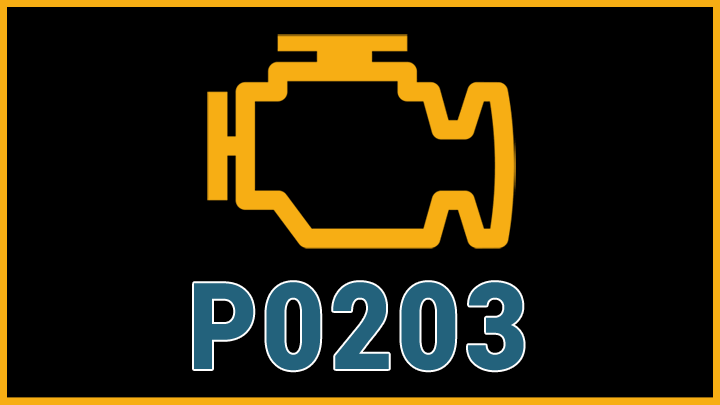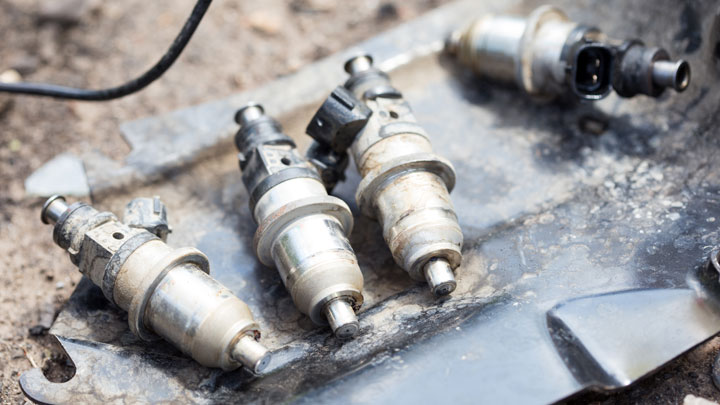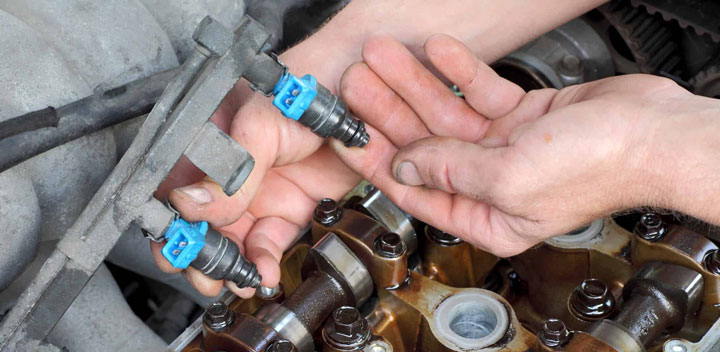P0203 Code (Symptoms, Causes, and How to Fix)
Has your vehicle recently begun displaying a dreaded “check engine light”, which has been traced back to a P0203 fault code? If so, you probably find yourself perplexed, wondering what this code means, and how it is best addressed.
The P0203 code indicates a problem with a specific fuel injector circuit. We will examine what causes a P0203 code, how it affects driving, and most importantly, how to fix it.

What Does Code P0203 Mean?
Diagnostic trouble code P0203 is indicative of a fuel injection system fault, or more specifically, a defined fault within the control circuit of a specific fuel injector. In this particular case, the fault in question pertains to an engine’s #3 fuel injector.
This is a “perceived” fault, in the fact that the the affected vehicle’s PCM has sensed irrational feedback from the #3 injector circuit, thereby signifying a potential issue.
To better understand this principle, one must first understand the base theory of fuel injection operation. Each of an engine’s fuel injectors is actuated by individual solenoids, powered by a vehicle’s ECM/PCM.
Both voltage and resistance within each respective fuel injector circuit are monitored for measured abnormalities by the ECM/PCM at all times.
Once an injector’s solenoid is commanded “on”, a vehicle’s ECM/PCM expects to see a predicted momentary drop in circuit voltage. This voltage should then rebound to a fixed baseline in an almost immediate fashion.
Overall circuit resistance is also measured simultaneously, in an attempt to earmark poor circuit integrity, and/or faulty solenoids.
In the event of diagnostic fault code P0203, a vehicle’s ECM/PCM is not registering the anticipated electrical feedback from the engine’s #3 fuel injector circuit, during a commanded injection event. Similar codes such as P0201, P0202, and P0204 refer to their corresponding injector.
This discrepancy is then logged in the form of an active diagnostic fault code, which ultimately leads to the illumination of a vehicle’s check engine light.
Symptoms of Code P0203

Diagnostic fault code P0203 is often accompanied by a host of secondary symptoms, some of which tend to be more noticeable than others. Those capable of recognizing these symptoms are typically well-equipped to diagnose the issue at hand, in an expedient fashion.
The following are several of the most common symptoms associated with DTC P0203.
- Illuminated check engine light
- Engine misfire
- Poor performance under load
- Erratic idle
- Reduced fuel economy
- Potential stalling
Causes of Code P0203

Diagnostic fault code P0203 can be caused by one of several different underlying issues, some of which can be somewhat difficult to discern. Therefore, it is important to familiarize yourself with all possible causes of the issue at hand.
The following are several of the most probable causes of DTC P0203.
- Faulty fuel injector
- Shorted wiring to the injector
- Open wire to the injector
- Compromised circuit connector
- Bad PCM
Is Code P0203 Serious?
Diagnostic fault code P0203 is generally considered to be of moderate severity. This is due to the number of driveability-related symptoms associated with this fault, many of which tend to be rather severe in nature. In some cases, these symptoms can become even more severe in time.
The underlying conditions identified by P0203 are almost always attributed to a noticeable misfire. This, in turn, often leads to a lack of overall engine performance, especially under a load.
Additionally, a vehicle’s fuel economy often suffers in the midst of an active code. In the most severe of cases, intermittent engine stalling can even result.
In any event, the root cause of a vehicle’s P0203 fault code should be thoroughly diagnosed and repaired as soon as possible. Doing so will ensure that your vehicle is returned to peak efficiency and reliability in short order. If you do not feel comfortable tackling such repairs yourself, an appointment should be made with a trusted service center at the first available opportunity.
Regardless of the specific cause, a P0203 diagnostic trouble code in a vehicle requires prompt diagnosis and repair. Fixing the underlying issue is the only way to restore the engine to full efficiency.
If you don’t feel confident in your abilities to make the repair yourself, you should schedule a service appointment with a reputable shop right away. Delaying action on a P0203 code risks further performance issues and potential damage.
How to Fix Code P0203

The following steps can be used to assist you in diagnosing the root cause of your vehicle’s P0203 diagnostic fault code. As always, be sure to consult factory-specific service literature before attempting any such repairs.
#1 – Scan For Additional Codes
Before beginning the diagnostic process, one should check for the presence of additional diagnostic fault codes with an OBD2 scan tool. Any such codes that are found should be thoroughly diagnosed before proceeding.
#2 – Visually Inspect Injector/Connector
Begin the diagnostic process by performing a thorough visual inspection of your engine’s #3 fuel injector and related connector. Any such damage should be repaired before proceeding, if possible. If necessary, replace any and all damaged components.
#3 – Check Sensor Resistance
If no evidence of damage is apparent under inspection, a resistance test should be performed. A digital multimeter can be used to check resistance across the #3 injector’s solenoid.
These readings should be compared to those specified by your vehicle’s manufacturer. If these readings fall outside of specification, the affected injector should be replaced.
#4 – Swap Injectors
If testing has still proved inconclusive, the engine’s #3 fuel injector should be swapped with an injector from any other cylinder. After running the engine, one should then determine whether the offending DTC has stayed with the #3 cylinder, or moved to the cylinder in which the original injector is now located.
If the fault still persists on cylinder #3, the injector circuit itself becomes suspect. If the fault moves with the location of the injector, the offending injector should be replaced.
#5 – Ohm Out Circuit Wiring
If your vehicle’s P0203 fault persists, continuity should be checked across each individual wire in the #3 injector harness. This can be done with the use of a digital multimeter, and a factory-specific wiring diagram.
All wires should have continuity between their connector ends at the injector and their terminating ends at the ECM/PCM. If this is not the case, an “open” circuit exists and should be further diagnosed.
#6 – Check For Excess Circuit Resistance
If no “open” condition is identified, overall circuit resistance should be measured with a multimeter, across each wire independently. These resistance readings should be compared to those specified by the vehicle’s manufacturer.
If no excess resistance is identified, the issue at hand likely originates at the ECM/PCM.
- P06dd Code (Symptoms, Causes, and How to Fix) - May 3, 2024
- 5 Symptoms of an EVAP Leak (and Repair Cost) - Apr 27, 2024
- P0480 Code (Symptoms, Causes, and How to Fix) - Apr 19, 2024
